非谓语动词作状语教学提纲
- 格式:ppt
- 大小:156.00 KB
- 文档页数:12
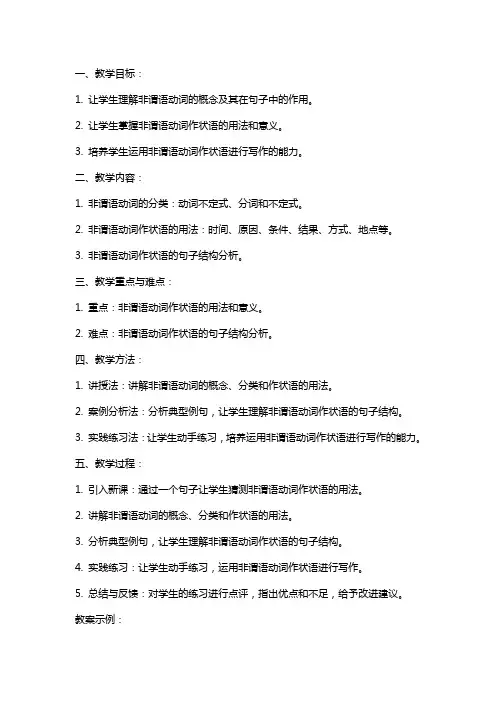
1. 让学生理解非谓语动词的概念及其在句子中的作用。
2. 让学生掌握非谓语动词作状语的用法和意义。
3. 培养学生运用非谓语动词作状语进行写作的能力。
二、教学内容:1. 非谓语动词的分类:动词不定式、分词和不定式。
2. 非谓语动词作状语的用法:时间、原因、条件、结果、方式、地点等。
3. 非谓语动词作状语的句子结构分析。
三、教学重点与难点:1. 重点:非谓语动词作状语的用法和意义。
2. 难点:非谓语动词作状语的句子结构分析。
四、教学方法:1. 讲授法:讲解非谓语动词的概念、分类和作状语的用法。
2. 案例分析法:分析典型例句,让学生理解非谓语动词作状语的句子结构。
3. 实践练习法:让学生动手练习,培养运用非谓语动词作状语进行写作的能力。
五、教学过程:1. 引入新课:通过一个句子让学生猜测非谓语动词作状语的用法。
2. 讲解非谓语动词的概念、分类和作状语的用法。
3. 分析典型例句,让学生理解非谓语动词作状语的句子结构。
4. 实践练习:让学生动手练习,运用非谓语动词作状语进行写作。
5. 总结与反馈:对学生的练习进行点评,指出优点和不足,给予改进建议。
教案示例:a. 让学生理解非谓语动词的概念及其在句子中的作用。
b. 让学生掌握非谓语动词作状语的用法和意义。
c. 培养学生运用非谓语动词作状语进行写作的能力。
2. 教学内容:a. 非谓语动词的分类:动词不定式、分词和不定式。
b. 非谓语动词作状语的用法:时间、原因、条件、结果、方式、地点等。
c. 非谓语动词作状语的句子结构分析。
3. 教学重点与难点:a. 重点:非谓语动词作状语的用法和意义。
b. 难点:非谓语动词作状语的句子结构分析。
4. 教学方法:a. 讲授法:讲解非谓语动词的概念、分类和作状语的用法。
b. 案例分析法:分析典型例句,让学生理解非谓语动词作状语的句子结构。
c. 实践练习法:让学生动手练习,培养运用非谓语动词作状语进行写作的能力。
5. 教学过程:a. 引入新课:通过一个句子让学生猜测非谓语动词作状语的用法。
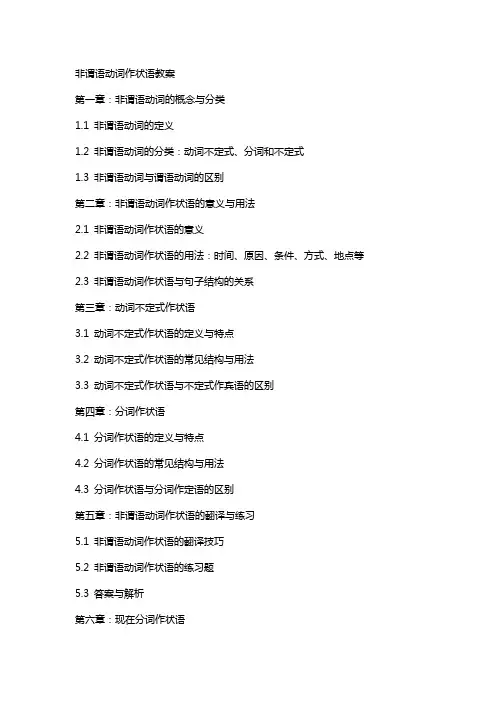
非谓语动词作状语教案第一章:非谓语动词的概念与分类1.1 非谓语动词的定义1.2 非谓语动词的分类:动词不定式、分词和不定式1.3 非谓语动词与谓语动词的区别第二章:非谓语动词作状语的意义与用法2.1 非谓语动词作状语的意义2.2 非谓语动词作状语的用法:时间、原因、条件、方式、地点等2.3 非谓语动词作状语与句子结构的关系第三章:动词不定式作状语3.1 动词不定式作状语的定义与特点3.2 动词不定式作状语的常见结构与用法3.3 动词不定式作状语与不定式作宾语的区别第四章:分词作状语4.1 分词作状语的定义与特点4.2 分词作状语的常见结构与用法4.3 分词作状语与分词作定语的区别第五章:非谓语动词作状语的翻译与练习5.1 非谓语动词作状语的翻译技巧5.2 非谓语动词作状语的练习题5.3 答案与解析第六章:现在分词作状语6.1 现在分词作状语的定义与特点6.2 现在分词作状语的常见结构与用法6.3 现在分词作状语与过去分词作状语的区别第七章:过去分词作状语7.1 过去分词作状语的定义与特点7.2 过去分词作状语的常见结构与用法7.3 过去分词作状语与现在分词作状语的区别第八章:非谓语动词作状语的句子分析8.1 非谓语动词作状语的句子结构分析8.2 非谓语动词作状语的句子类型分析8.3 非谓语动词作状语的句子实例分析第九章:非谓语动词作状语的语法辨析9.1 非谓语动词作状语与作宾语的语法辨析9.2 非谓语动词作状语与作定语的语法辨析9.3 非谓语动词作状语与作补语的语法辨析第十章:非谓语动词作状语的综合练习与解答10.1 非谓语动词作状语的综合练习题10.2 答案与解析10.3 非谓语动词作状语的实践与应用重点和难点解析一、非谓语动词的分类:动词不定式、分词和不定式补充说明:动词不定式作状语时,常常表示目的、结果、原因等;分词作状语时,可以表示时间、原因、条件等;不定式作状语时,通常表示方式、地点等。

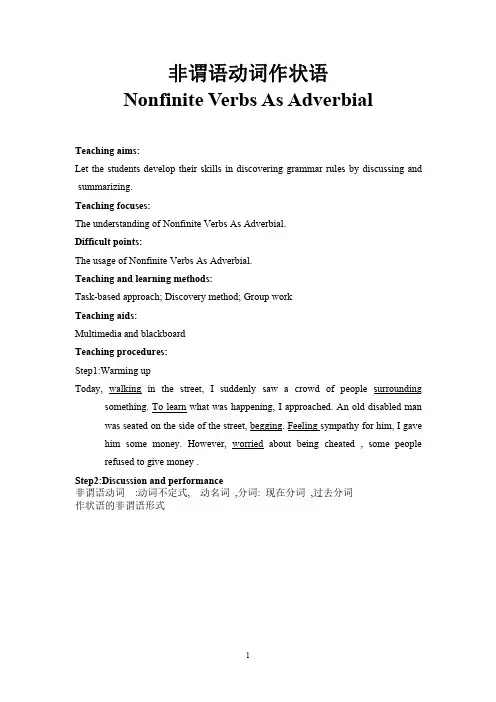
非谓语动词作状语Nonfinite Verbs As AdverbialTeaching aims:Let the students develop their skills in discovering grammar rules by discussing and summarizing.Teaching focuses:The understanding of Nonfinite Verbs As Adverbial.Difficult points:The usage of Nonfinite Verbs As Adverbial.Teaching and learning methods:Task-based approach;Discovery method;Group workTeaching aids:Multimedia and blackboardTeaching procedures:Step1:Warming upToday,walking in the street,I suddenly saw a crowd of people surrounding something.To learn what was happening,I approached.An old disabled man was seated on the side of the street,begging.Feeling sympathy for him,I gave him some money.However,worried about being cheated,some people refused to give money.Step2:Discussion and performance非谓语动词:动词不定式,动名词,分词:现在分词,过去分词作状语的非谓语形式To have doneTo bedone To do 不定式done过去分词Having done Beingdone doing 现在分词完成式被动式一般式 形式种类高考衔接1.____into English,the sentence was found to have an entirely different word order.(2019课标)A.Translating B.Translated C.To translate D.Having translated2._____around the fire,the tourists danced with the local people.(2011辽宁)A.Gather B.To gather C.Gathering D.Gathered3.There ____no classes yesterday,we paid a visit to The Great Wall.(2009全国)A.Was B .were C.being D.had been4._____the website of the Fire Department in your city ,and you will learn a lot about firefighting .(2018湖南)A To searchB .SearchingC .SearchD .Having searched5._____in the queue for half an hour,Tom suddenly realized that he had left his wallet at home.(2019全国)A.To waitB.Have waitedC.Having waitedD.To have waitedStep3:Checking and practiceCheck the facts with the students and do some practice.一.分析句子结构一个句子当中,已经存在一个主句(谓语动词),又没有连词的情况下,应考虑非谓语.二.分析逻辑主语确定要选非谓语动词之后,第二步要分析其逻辑主语,其逻辑上的动作执行者就叫做逻辑主语。

非谓语动词作状语在写作中的应用课时安排:每章2课时,共10课时第一章:非谓语动词概述1.1 非谓语动词的定义和分类1.2 非谓语动词的作用和用法1.3 非谓语动词与谓语动词的关系第二章:非谓语动词作状语的定义和功能2.1 非谓语动词作状语的定义2.2 非谓语动词作状语的功能和作用2.3 非谓语动词作状语的常见类型第三章:非谓语动词作状语的构成和用法3.1 现在分词作状语3.1.1 现在分词作时间状语3.1.2 现在分词作原因状语3.1.3 现在分词作条件状语3.2 过去分词作状语3.2.1 过去分词作结果状语3.2.2 过去分词作方式状语3.2.3 过去分词作伴随状语3.3 不定式作状语3.3.1 不定式作目的状语3.3.2 不定式作结果状语3.3.3 不定式作原因状语第四章:非谓语动词作状语的注意事项4.1 非谓语动词作状语的逻辑主语4.2 非谓语动词作状语的主谓关系4.3 非谓语动词作状语的时态和语态第五章:非谓语动词作状语在写作中的应用实例5.1 现在分词作状语的应用实例5.2 过去分词作状语的应用实例5.3 不定式作状语的应用实例教学评估:通过课堂讲解、练习和写作实践,评估学生对非谓语动词作状语的理解和应用能力。
教学资源:教案、PPT、练习题、写作材料。
教学方法:采用讲解、练习和写作实践相结合的方式,帮助学生理解和掌握非谓语动词作状语的用法。
通过实例分析和练习,培养学生在写作中灵活运用非谓语动词作状语的能力。
第六章:现在分词作状语的扩展应用6.1 现在分词作让步状语6.2 现在分词作转折状语6.3 现在分词作对比状语第七章:过去分词作状语的扩展应用7.1 过去分词作假设状语7.2 过去分词作强调状语7.3 过去分词作比较状语第八章:不定式作状语的扩展应用8.1 不定式作可能状语8.2 不定式作选择状语8.3 不定式作程度状语第九章:非谓语动词作状语的复合应用9.1 非谓语动词作状语的复合结构9.2 现在分词与过去分词的复合应用9.3 不定式与现在分词、过去分词的复合应用第十章:非谓语动词作状语在写作中的高级应用10.1 非谓语动词作状语的连用10.2 非谓语动词作状语的独立主格结构10.3 非谓语动词作状语的倒装句式教学评估:通过课堂讲解、练习和写作实践,评估学生对非谓语动词作状语的理解和应用能力。
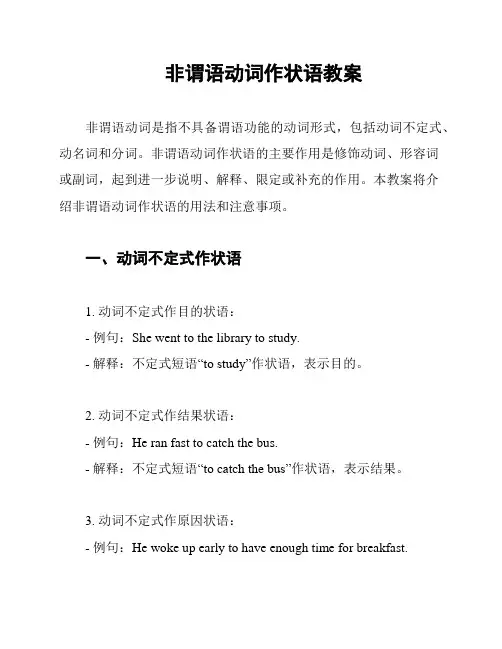
非谓语动词作状语教案非谓语动词是指不具备谓语功能的动词形式,包括动词不定式、动名词和分词。
非谓语动词作状语的主要作用是修饰动词、形容词或副词,起到进一步说明、解释、限定或补充的作用。
本教案将介绍非谓语动词作状语的用法和注意事项。
一、动词不定式作状语1. 动词不定式作目的状语:- 例句:She went to the library to study.- 解释:不定式短语“to study”作状语,表示目的。
2. 动词不定式作结果状语:- 例句:He ran fast to catch the bus.- 解释:不定式短语“to catch the bus”作状语,表示结果。
3. 动词不定式作原因状语:- 例句:He woke up early to have enough time for breakfast.- 解释:不定式短语“to have enough time for breakfast”作状语,表示原因。
二、动名词作状语1. 动名词作时间状语:- 例句:I enjoy swimming in the morning.- 解释:动名词短语“swimming in the morning”作状语,表示时间。
2. 动名词作原因状语:- 例句:She failed the exam due to not studying enough.- 解释:动名词短语“not studying enough”作状语,表示原因。
三、分词作状语1. 现在分词作时间状语:- 例句:Walking along the street, she noticed a bookstore.- 解释:现在分词短语“Walking along the street”作状语,表示时间。
2. 过去分词作原因状语:- 例句:Feeling tired, he decided to take a break.- 解释:过去分词短语“Feeling tired”作状语,表示原因。
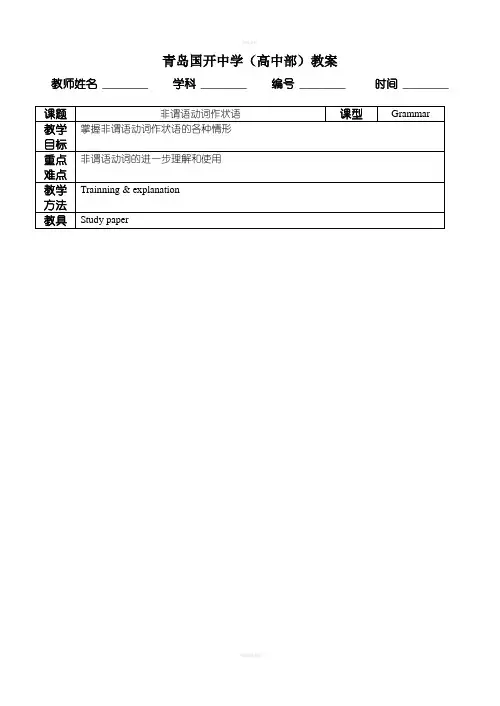
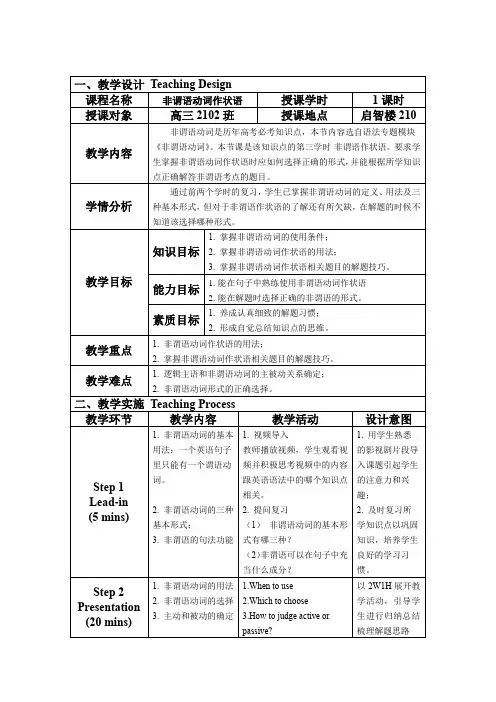
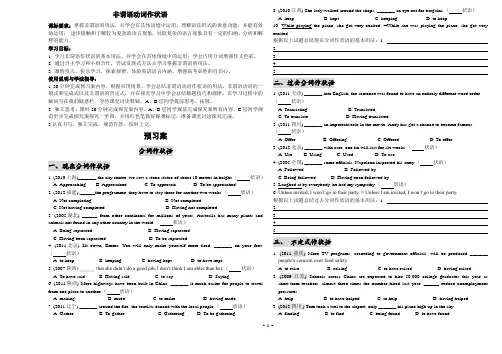
非谓语动词作状语课标要求:掌握非谓语的用法,并学会在具体语境中运用。
理解语法形式的表意功能,并能有效地运用;逐步接触和了解较为复杂的语言现象,对较复杂的语言现象具有一定的归纳、分析和解释的能力。
学习目标:1. 学习非谓语作状语的基本用法,并学会在具体情境中的运用;学会巧用分词增强作文色彩。
2. 通过自主学习和小组合作,尝试发现式方法去学习掌握非谓语的用法。
3. 激情投入,快乐学习,探索规律,体验英语语言内涵,增强高考必胜的自信心。
使用说明与学法指导:1. 30分钟完成预习案内容,根据应用情景,学会总结非谓语动词作状语的用法,非谓语动词的一般式和完成式以及非谓语的否定式,并在探究学习中学会总结解题技巧和规律。
在学习过程中的疑问写在我的疑惑栏,等待课堂讨论释疑。
A、B层同学提前思考、拓展。
2. 独立思考,限时20分钟完成探究案内容。
A、B层同学规范完成探究案所有内容,C层同学规范至少完成探究案探究一至四,并用红色笔做好疑难标记,准备课堂讨论探究完成。
3.认真书写,独立完成,规范作答,按时上交。
预习案分词作状语一、现在分词作状语1. (2010上海)_______ the city centre, we saw a stone statue of about 10 metres in height.(状语)A. ApproachingB. ApproachedC. To approachD. To be approached2. (2012福建) ______the programme, they have to stay there for another two weeks.(状语)A. Not completingB. Not completedC. Not having completedD. Having not completed3. (2005湖北) ______ from other continents for millions of years, Australia has many plants and animals not found in any other country in the world.(状语)A. Being separatedB. Having separatedC. Having been separatedD. To be separated4. (2011北京) Sit down, Emma. You will only make yourself more tired, _______ on your feet.(状语)A. to keepB. keepingC. having keptD. to have kept5. (2007陕西) ______ that she didn’t do a good job, I don’t think I am abler than her.(状语)A. To have saidB. Having saidC. to sayD. Saying6. (2011陕西) More highways have been built in China, _______ it much easier for people to travel from one place to another.(状语)A. makingB. madeC. to makeD. having made 7. (2011辽宁) _______ around the fire, the tourists danced with the local people.(状语)A. GatherB. To gatherC. GatheringD. To be gathering8. (2010江西) The lady walked around the shops, _______ an eye out for bargains.(状语)A. keepB. keptC. keepingD. to keep10. While playing the piano, she got very excited. =While she was playing the piano, she got very excited.根据以上试题总结现在分词作状语的基本用法:1.2.3.4.5二、过去分词作状语1. (2011天津) _______ into English, the sentence was found to have an entirely different word order.(状语)A. TranslatingB. TranslatedC. To translateD. Having translated2. (2011四川) _______ an important role in the movie, Andy has got a chance to become famous.(状语)A. OfferB. OfferingC. OfferedD. To offer3. (2012北京) _______ with care, one tin will last for six weeks.(状语)A. UseB. UsingC. UsedD. To use4. (2005全国) _______ some officials, Napoleon inspected his army.(状语)A. FollowedB. Followed byC. Being followedD. Having been followed by5. Laughed at by everybody, he had my sympathy.(状语)6. Unless invited, I won’t go to their party. = Unless I am invited, I won’t go to their party.根据以上试题总结过去分词作状语的基本用法:1.2.3.4.5.三、不定式作状语1. (2011重庆) More TV programs, according to government officials, will be produced _______ people’s concern over food safety.A. to raiseB. raisingC. to have raisedD. having raised2. (2009江苏) Schools across China are expected to hire 50,000 college graduates this year as short-term teachers, almost three times the number hired last year, ______ reduce unemploymentpressures.A. helpB. to have helpedC. to helpD. having helped3. (2012四川,) Tom took a taxi to the airport, only _______ his plane high up in the sky.A. findingB. to findC. being foundD. to have found4. (2012山东) George returned after the war, only _______ that his wife had left him.A. to be toldB. tellingC. being toldD. told5. (2010辽宁) We were astonished _______ the temple still in its original condition.A. findingB. to findC. findD. to be find6. (2012全国II) The old man sat in front of the television every evening, happy _______ anything that happened to be on.A. to watchB. watchingC. watchedD. to have watched根据以上试题总结不定式作状语的基本用法:1.2.3.4.5.四、独立结构作状语(1)名词+分词作状语1. (2012全国I) The party will be held in the garden, weather _______.A. permittingB. to permitC. permittedD. permit2. (2011浙江) Bats are surprisingly long-lived creatures, some _______ a life span of around 20 years.A. havingB. hadC. haveD. to have3. (2005湖南) I send you 100 dollars today, the rest _______ in a year.A. followB. followedC. to followD. being followed4. (2007山东) The country has already sent up three unmanned spacecraft, the most recent ______ at the end of last March.A. has been launchedB. having been launchedC. being launchedD. to be launched比较下面两个句子:(1)The country has already sent up three unmanned spacecraft, the most recent of which ______ at the end of last March.A. has been launchedB. having been launchedC. was launchedD. to be launched(2)The country has already sent up three unmanned spacecraft, the fourth ______ at the end of next March.A. has been launchedB. having been launchedC. being launchedD. to be launched (2)With+名词短语+非谓语作状语1. (2004北京) _______two exams to worry about, I have to work really hard this weekend.A. WithB. BesidesC. As forD. Because of2. (2012辽宁) The old couple often take a walk after supper in the park with their pet dog _______ them.A. to followB. followingC. followedD. follows3. (2010山东)The living room is clean and tidy, with a dining table already _______ for a meal to be cooked.A. laidB. layingC. to layD. being laid4. (2009上海) With a lot of difficult problems_______, the newly-elected president is having a hard time.A. settledB. settlingC. to settleD. being settled根据以上试题总结独立结构的基本用法:1.2.3.4.5.五、固定结构作状语1. 副词+speakingGenerally speaking, men are stronger than women.2.分词+介词Judging from his expression, he is in a lousy mood.Allowing for her inexperience, she has done a good job.Talking of English, she is the best speaker.Taking everything into consideration, they ought to win this game.3. 分词+(that)从句Considering/Allowing that she has no experience, she has done a good job.Considering how far from perfect most human brains are, there isn't much threat from a computer. Supposing there was a war, what would you do?Granting that he has made a mistake, he is not to blame, for he intended to help us.我的疑问:探究案探究一:谓语或非谓语的确定比较下面三个句子:(1) In the dark forest lie many lakes, some of them large enough to hold several English towns.(2) In the dark forest lie many lakes, and some of them are large enough to hold several English towns.(3) In the dark forest lie many lakes, some of which are large enough to hold several English towns. Practice:1. He walked down the hills, softly to himself. (sing)2. He walked down the hills, and softly to himself. (sing)探究二:逻辑主语的确定判断下面句子的正误,并把错的改正过来。
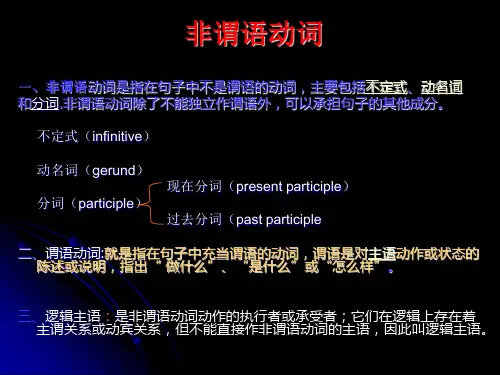
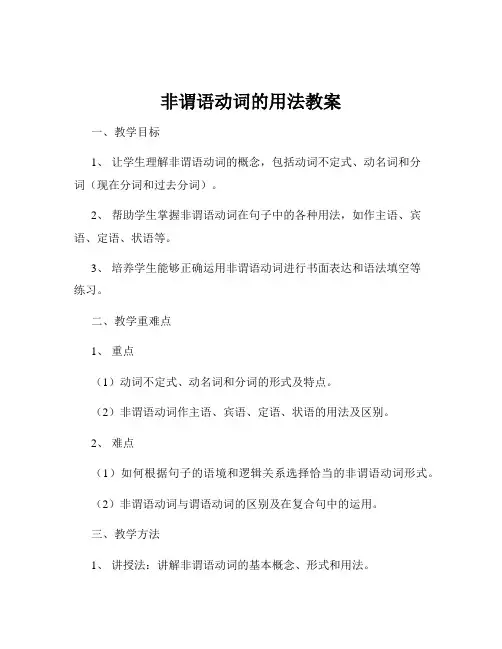
非谓语动词的用法教案一、教学目标1、让学生理解非谓语动词的概念,包括动词不定式、动名词和分词(现在分词和过去分词)。
2、帮助学生掌握非谓语动词在句子中的各种用法,如作主语、宾语、定语、状语等。
3、培养学生能够正确运用非谓语动词进行书面表达和语法填空等练习。
二、教学重难点1、重点(1)动词不定式、动名词和分词的形式及特点。
(2)非谓语动词作主语、宾语、定语、状语的用法及区别。
2、难点(1)如何根据句子的语境和逻辑关系选择恰当的非谓语动词形式。
(2)非谓语动词与谓语动词的区别及在复合句中的运用。
三、教学方法1、讲授法:讲解非谓语动词的基本概念、形式和用法。
2、练习法:通过课堂练习和课后作业,让学生巩固所学知识。
3、比较法:对非谓语动词的不同形式和用法进行比较,加深学生的理解。
四、教学过程(一)导入通过一个简单的句子:“I like reading books” 引出动词“read”的不同形式“reading”,从而导入非谓语动词的概念。
(二)讲解非谓语动词的概念非谓语动词是指在句子中不充当谓语的动词形式,包括动词不定式(to do)、动名词(doing)和分词(现在分词 doing 和过去分词done)。
(三)详细讲解非谓语动词的形式和特点1、动词不定式(1)形式:to +动词原形(有时可以省略 to)(2)特点:具有动词的特征,可以带宾语、状语等;具有名词、形容词和副词的特征,可以在句子中作主语、宾语、定语、状语等。
2、动名词(1)形式:动词原形+ ing(2)特点:具有名词的特征,在句子中可以作主语、宾语、定语等。
3、分词(1)现在分词:动词原形+ ing(2)过去分词:动词原形+ ed(规则动词);不规则动词的过去分词需单独记忆。
(3)特点:现在分词具有形容词和副词的特征,在句子中可以作定语、状语、补语等;过去分词具有形容词和副词的特征,在句子中可以作定语、状语、补语等。
(四)非谓语动词作主语1、动词不定式作主语(1)通常表示具体的、一次性的动作。
非谓语动词作状语全解不定式和分词作状语的用法一、不定式作状语可以作:1。
主要用作目的状语。
常与 in order to do (为了或 so as to do(以便连用。
so as to 不用于居首。
He got up early in order to catch the first bus. 他早起为了赶上第一班车。
He sat down to have a rest。
他坐下来休息。
He went to France to learn French. 他去法国学习法语.They stood by the roadside to talk about the plan.他们站在路边为的是谈论这个计划。
They stopped to ask the way. 他们停下来问路. (停下来的目的2。
作结果状语。
表示出乎意料的结果。
做结果状语的不定式只能出现在句子的末尾,常见的不定式动词有:to find, to hear, to see, to be told, to form, to give, to make,to produce 等。
He hurried to the station only to find the train gone. 他匆匆忙忙地赶到火车站,发现火车已经开走了.He woke up to find everybody gone。
他醒来发现大家都走了。
His family was too poor to support him。
他的家庭太穷,不能维持他的生活. The boy is not tall enough to reach the book shelf。
这男孩个子不够高, 手伸不到书架。
He is old enough to go to school。
他到上学年龄了.He lifted a rock only to drop it on his own feet.他搬起石头砸了自己的脚。
非谓语动词做状语蒙城一中高中英语张桂月教学背景According to the National New Curriculum Standard, there are three main objectives of senior English instruction, that is, the objective of knowledge and abilities, the objective of processes and methods, the objective of emotions, attitudes and values. So, in this period, not only will students be given knowledge, but also I will cultivate their abilities, and show them how to learn, and what’ more, there will be moral education and values education. In all, my teaching will meet the needs of new curriculum reform.教材分析This is the revision of infinitive used as adverbial , which plays a dominating role in the grammar. So I choose a lot of typical examples to help them master the usages as a whole. Also, I write a short passage myself to give them a practical situation to practice using the infinitive correctly.学情分析Most Ss have already mastered certain usages of the infinitive. However, some Ss’ basis is very weak. They are not good at communication in English and lack of motivation in English learning. So, only by arranging some interesting activities and adopting effective teaching methods can good teaching results be achieved.教学重点1.Enable students to know how to do such exercises.2.Enable students to learn to use the infinitive as adverbial.3.Conduct moral education.教学难点a. Cooperative learning: I will design some tasks for students to finish in their cooperative learning.b. Autonomous learning: Students will finish their tasks by themselves after class with the help of the teacher and their classmates.c. Communicative strategies: With communicative strategy, teacher will no longer be the center of the class. Instead, teacher acts only as the helper, the guider, and advisor; it is students themselves that will be the center of the class.教学目标(1) Knowledge and abilities:a. Help the students grasp the usage of adverbial used as adverbial.b. Help the students fill in the blanks correctly.(2) Processes and methods:a. To improve students’ ability in solving the problems.b. To improve students’ ability in conclusion.(3) Emotions, attitudes and values:a. Encourage the students to learn to challenge themselves and be brave in their future life.b. Get students to be ready to help whoever is in trouble .教学方法1. Cooperative learning: I will design some tasks for students to finish in their cooperative learning.2. Autonomous learning: Students will finish their tasks by themselves after class with the help of the teacher and their classmates.3. Communicative strategies: With communicative strategy, teacher will no longer be the center of the class. Instead, teacher acts only as the helper, the guider, and advisor; it is students themselves that will be the center of the class.教学手段A multi-media computer system with a overhead projector教学步骤:Step 1 Lead inFirst I will ask students to analyse the structure of the sentences.1)The girl is Mary .2)If I am given more time, I’ ll catch up with you.3)The girl dancing in the hall is Mary.4)Given more time, I’ll catch up with you.结论:非谓语动词,不是做谓语的动词。